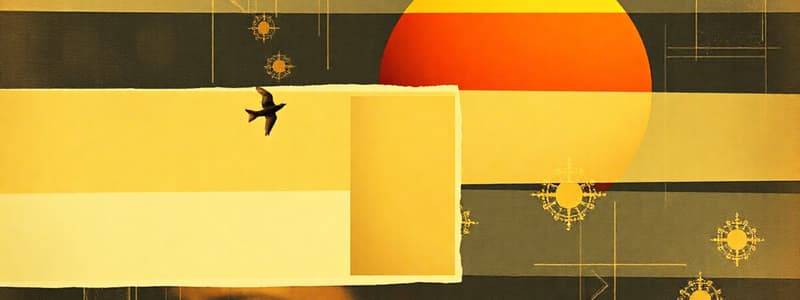Podcast
Questions and Answers
What process allows us to see objects in a room when the lights are on?
What process allows us to see objects in a room when the lights are on?
- Reflection (correct)
- Diffraction
- Refraction
- Transmission
Why does the sun emit a different color of light compared to a bonfire?
Why does the sun emit a different color of light compared to a bonfire?
- Bonfires burn more types of gases compared to the sun.
- The sun burns brighter gases than bonfires do.
- The sun emits light through different types of chemical reactions. (correct)
- The burning temperatures of the sun and bonfire are equivalent.
What happens to light when it is absorbed by an object?
What happens to light when it is absorbed by an object?
- It cannot be seen by the human eye. (correct)
- It becomes visible to the human eye.
- It is transformed into different light waves.
- It alters the object's color to a brighter shade.
Which property of light describes its behavior when it bounces off an object?
Which property of light describes its behavior when it bounces off an object?
What type of energy is created from the burning of gasses?
What type of energy is created from the burning of gasses?
What characteristic do opaque objects possess?
What characteristic do opaque objects possess?
Why does a yellow blanket appear yellow under a bright light bulb?
Why does a yellow blanket appear yellow under a bright light bulb?
What is the result when light waves travel through a medium and bend?
What is the result when light waves travel through a medium and bend?
How is light categorized based on its interaction with objects it encounters?
How is light categorized based on its interaction with objects it encounters?
Which of the following best explains why certain colors are seen from objects?
Which of the following best explains why certain colors are seen from objects?
Flashcards
Electromagnetic Energy
Electromagnetic Energy
A type of energy that travels in waves and creates light, heat, and other phenomena.
Reflection
Reflection
The process of light bouncing off a surface.
Opaque Object
Opaque Object
A material that light cannot pass through, like a wall.
Absorption
Absorption
Signup and view all the flashcards
Light Spectrum
Light Spectrum
Signup and view all the flashcards
Color of an Object
Color of an Object
Signup and view all the flashcards
Transmission
Transmission
Signup and view all the flashcards
Refraction
Refraction
Signup and view all the flashcards
Combustion
Combustion
Signup and view all the flashcards
Waves
Waves
Signup and view all the flashcards
Study Notes
Light and its Properties
- Light is produced when gasses burn, creating electromagnetic energy in the form of magnetic and electrical waves.
- The type of gasses burned determine the color of light emitted.
- Light behaves differently depending on the object it encounters.
Reflection
- An object must reflect light for it to be seen.
- Reflection occurs when light bounces off opaque objects (objects you cannot see through).
- Light from a light source travels to an object, reflects off the object, and then reaches your eyes.
Absorption
- Some light is absorbed by an object rather than reflected.
- Absorbed light waves are not visible to the human eye.
- The colors we see are determined by the light waves that are reflected, and not those that are absorbed.
- For example, a yellow blanket absorbs all colors except yellow, so it reflects yellow light waves.
Transmission
- Light can pass through transparent objects (objects that allow you to see through them).
- Transmission occurs when light waves pass through and out the other side of the object.
- An example of transmission is sunlight passing through a glass window.
Studying That Suits You
Use AI to generate personalized quizzes and flashcards to suit your learning preferences.




